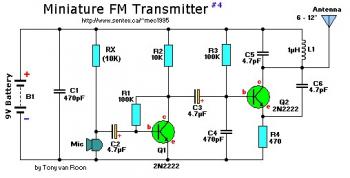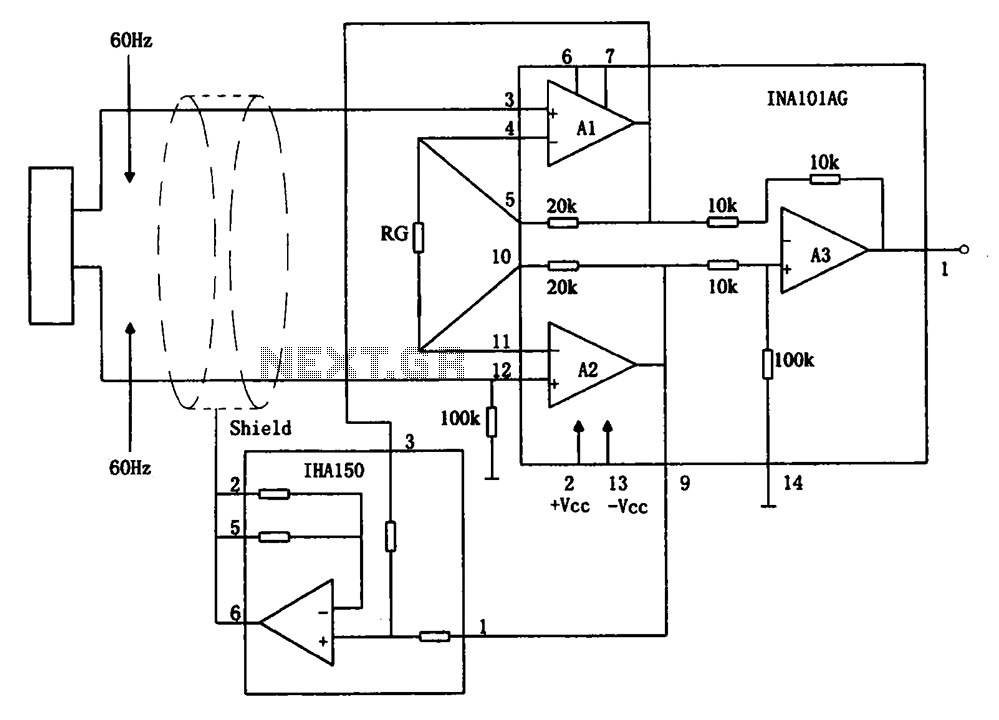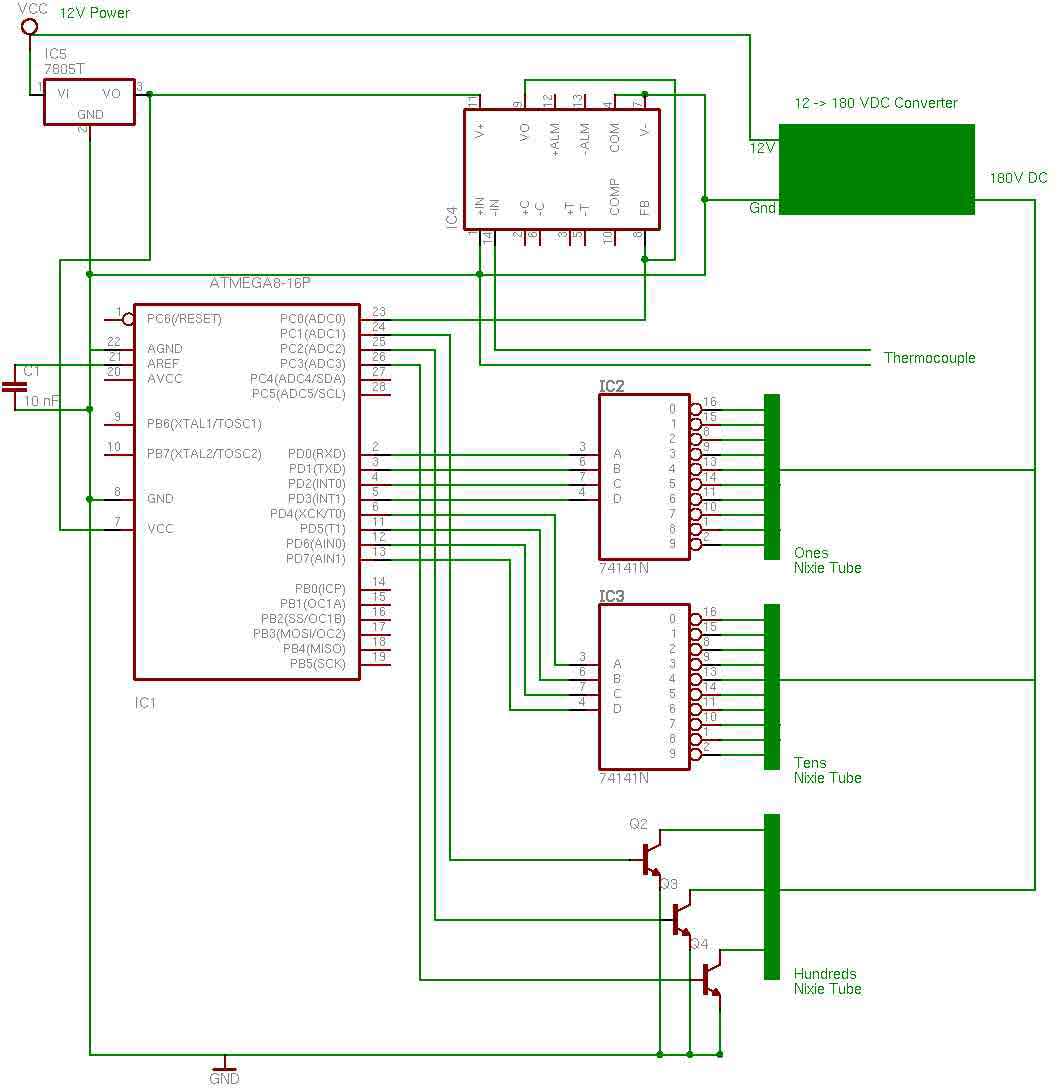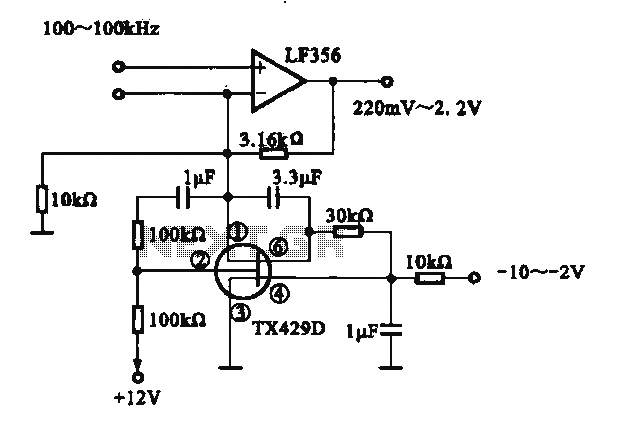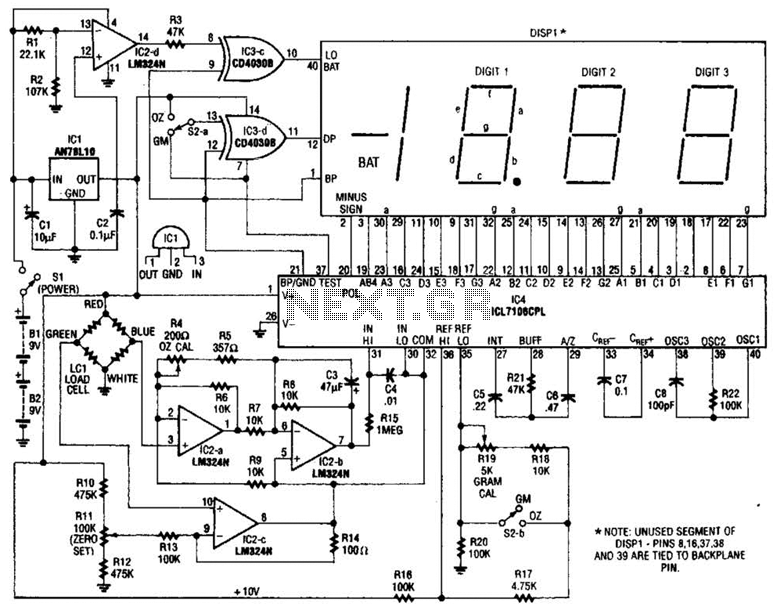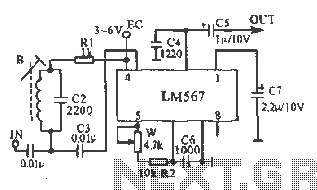
100kHz-30MHz active antenna circuit diagram
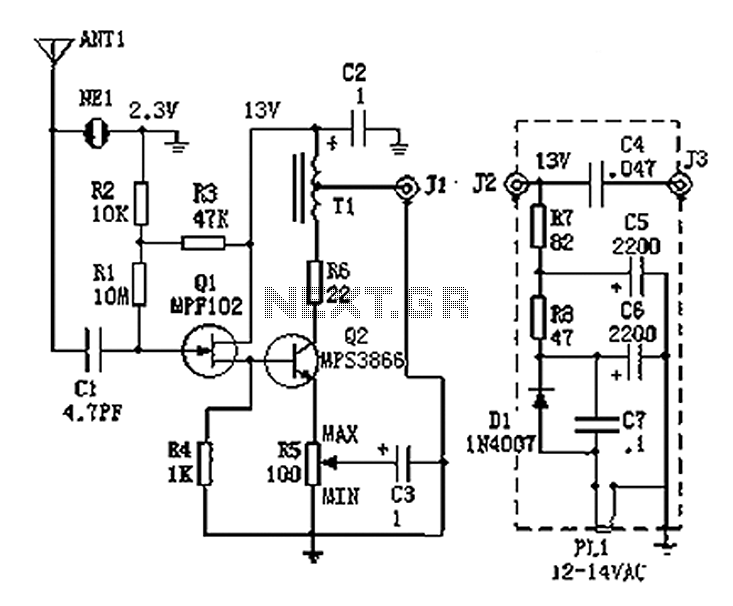
An active antenna operating within the frequency range of 100 kHz to 30 MHz, characterized by its compact size and effective performance. It is designed to be simple and low-cost, making it ideal for remote medium wave and short-wave radio reception. High-frequency junction FET Q1 (MPF102) is configured as a source follower, with the whip antenna ANT1 picking up radio frequency signals that are coupled to its gate through C1. C1 has high impedance to suppress power grid hum interference at 50 Hz and 100 Hz. The neon bulb NE1 serves as an electrostatic charge induction vent to protect Q1 from excessive electrostatic charge accumulation that could lead to gate breakdown. The antenna is enclosed in a PVC pipe, which can generate high electrostatic potential due to friction, increasing sensitivity to electrostatic charge and potentially damaging C1 and Q1. Biasing resistors R1-R3 provide a 2.5V bias to the gate of Q1. The RF output signal from Q1 is amplified by Q2 (UHF transistor MPS3866), providing a load with 100 mW output power. Q2 operates at a quiescent current of approximately 30-40 mA to maintain good linearity during large signal processing. The gain is adjustable via the wiper of potentiometer R5, which is connected to the Q2 emitter circuit, allowing for AC bypass through C3. When R5 is adjusted to bypass C3, the minimum voltage gain of Q2 is about six times, contributing to an overall gain of approximately 36 dB when considering the antenna cable. R5 should be set to optimize weak signal reception while maintaining the best dynamic range. T1 is a broadband transformer wound on a toroidal ferrite core, determining the bandwidth of the antenna amplifier and providing impedance matching. The winding impedance ratio is 9:1, converting the 50-70 ohm antenna input impedance from Q1 and Q2 into 450-680 ohms, which T1 then converts back to 50-75 ohms for matching with the receiver's input impedance. Resistors R6 inhibit potential parasitic oscillation from Q2, while the DC power supply voltage is grounded through the cold side of T1 with capacitors. The amplifier has a -3 dB bandwidth of about 10 MHz, with low gain at high frequencies and high gain at lower frequencies. This design is particularly suitable for shortwave radio frequencies, where high gain is not desirable due to strong signals causing intermodulation. At approximately 1 MHz, the antenna can pick up weak signals, necessitating high gain from the amplifier. The low-end frequency of the amplifier is dependent on T1, estimated to be around 80 Hz, allowing coverage of the long-wave AM broadcast band of 140-425 kHz. The circuit is housed in a shielded box to minimize interference. Phantom power output is transmitted via coaxial cable from J1 to J2, where C4 couples the signal to the receiver connected at J3. A 13V DC supply is provided through J2 and J1 using the same length of coaxial cable for powering the antenna amplifier, with C4 preventing DC voltage from entering the receiver's antenna input circuit. A small wall power transformer supplies 12-14V AC voltage to socket PL1, which is half-wave rectified by diode D1 and filtered into 13V DC supply voltage through R7, R8, C5, and C6, with C7 serving as a bypass.
The design of this active antenna circuit is particularly advantageous for applications requiring a balance between sensitivity and selectivity, especially in environments with varying signal strengths. The choice of components, such as the MPF102 and MPS3866 transistors, is critical for achieving the desired frequency response and amplification characteristics. The implementation of a toroidal transformer (T1) not only facilitates impedance matching but also minimizes losses and enhances bandwidth, making the antenna suitable for a wide range of radio frequencies. The careful selection of capacitor values for C1, C3, C4, C5, C6, and C7 ensures effective filtering and stability of the circuit, while the biasing arrangement with resistors R1-R3 maintains the operational integrity of the FET. Overall, this active antenna circuit exemplifies a well-thought-out balance of performance, cost-effectiveness, and compact design, making it an excellent choice for amateur radio enthusiasts and professional applications alike.100kHz-30MHz active antenna with small size, good performance, making simple, low cost and so on, the most suitable for remote medium wave and short-wave radio reception. As sh own in FIG. High-frequency junction FET Q1 (MPF102) connected as a source follower, the whip antenna ANT1 radio frequency signal picked up by the C1 is coupled to its gate. For the purposes of the low-frequency signal, C1 has a high impedance can be suppressed power grid 50Hz and 100Hz hum interference.
neon NE1 electrostatic charge induction antenna vent let go, in order to protect Q1 not because of excessive accumulation of electrostatic charge and gate breakdown. this is because of the antenna packed in PVC pipe, easily generated by friction when dealing with high electrostatic potential, so that the antenna sensitive to electrostatic charge too much, so the breakdown C1 damage Q1.
biasing resistors R1-R3 to the gate of Q1 2.5V.Q1 biased to the source of the RF output signal after Q2 (UHF transistor MPS3866) to enlarge a load with 100mW output power .Q2 quiescent current of approximately 30-40mA, to maintain good linearity when processing large signal. Gain, its wiper connected to the Q2 emitter circuit of potentiometer R5 to mediate this antenna parallel to C3 from the AC bypass effect.
When R5 mediation is not C3 to bypass position, the minimum voltage gain of Q2, its value is about six times, then 2 times the antenna cable to the overall gain. when the impedance is taken into account, the gain of the output of this circuit is about 36dB.R5 should mediate weak signal reception to the best and lowest Useful gain position to maintain optimum dynamic range.
T1 is wound on a toroidal ferrite core broadband transformer, which determines the bandwidth of the antenna amplifier and play the role of impedance matching, the entire winding impedance ratio of one-third of the tap portion is 9: 1 From Q2 look past the collector. 50-70 ohm antenna input impedance is converted Q1, Q2 into 450-680 ohm, T1 this again converted into 50-75 ohm impedance, so that the output jack connected to the receiver input impedance matching to achieve J1 the resistors R6 inhibition Q2 possible parasitic oscillation DC power supply voltage via a T1 cold side AC-grounded capacitors.
The amplifier -3dB bandwidth of about 10MHz, high-frequency low gain, high gain and low-end. This fit the bill because higher frequencies at higher frequency antenna, the required gain is low. In particular, 12MHz and 15Mhz shortwave radio is sometimes very strong signal will cause intermodulation, the antenna gain of the amplifier is not too high. at about 1MHz, the antenna picked up a weak signal, which requires that the amplifier provides high gain.
the low-end amplifier frequency depends on T1, about near 80Hz, it is possible to cover the long-wave AM broadcast band of 140-425. The circuit in Figure dashed box mounted in the shield box, which is a radio frequency antenna signal amplifier circuit .J1 phantom power output by coaxial cable to one end of J2, and then the C4 is coupled to a receiver connected to J3.
Added 13V DC supply voltage of the J2 and J1 by the same length of coaxial cable for the antenna amplifier power, C4 cut off this DC voltage so that it can not enter receiver antenna input circuit. small wall power transformer secondary output of 12-14V AC voltage is applied to socket PL1, half-wave rectified by a diode D1 and R7, R8, C5, C6 after filtered by 13V DC supply voltage .C7 bypassing.
The design of this active antenna circuit is particularly advantageous for applications requiring a balance between sensitivity and selectivity, especially in environments with varying signal strengths. The choice of components, such as the MPF102 and MPS3866 transistors, is critical for achieving the desired frequency response and amplification characteristics. The implementation of a toroidal transformer (T1) not only facilitates impedance matching but also minimizes losses and enhances bandwidth, making the antenna suitable for a wide range of radio frequencies. The careful selection of capacitor values for C1, C3, C4, C5, C6, and C7 ensures effective filtering and stability of the circuit, while the biasing arrangement with resistors R1-R3 maintains the operational integrity of the FET. Overall, this active antenna circuit exemplifies a well-thought-out balance of performance, cost-effectiveness, and compact design, making it an excellent choice for amateur radio enthusiasts and professional applications alike.100kHz-30MHz active antenna with small size, good performance, making simple, low cost and so on, the most suitable for remote medium wave and short-wave radio reception. As sh own in FIG. High-frequency junction FET Q1 (MPF102) connected as a source follower, the whip antenna ANT1 radio frequency signal picked up by the C1 is coupled to its gate. For the purposes of the low-frequency signal, C1 has a high impedance can be suppressed power grid 50Hz and 100Hz hum interference.
neon NE1 electrostatic charge induction antenna vent let go, in order to protect Q1 not because of excessive accumulation of electrostatic charge and gate breakdown. this is because of the antenna packed in PVC pipe, easily generated by friction when dealing with high electrostatic potential, so that the antenna sensitive to electrostatic charge too much, so the breakdown C1 damage Q1.
biasing resistors R1-R3 to the gate of Q1 2.5V.Q1 biased to the source of the RF output signal after Q2 (UHF transistor MPS3866) to enlarge a load with 100mW output power .Q2 quiescent current of approximately 30-40mA, to maintain good linearity when processing large signal. Gain, its wiper connected to the Q2 emitter circuit of potentiometer R5 to mediate this antenna parallel to C3 from the AC bypass effect.
When R5 mediation is not C3 to bypass position, the minimum voltage gain of Q2, its value is about six times, then 2 times the antenna cable to the overall gain. when the impedance is taken into account, the gain of the output of this circuit is about 36dB.R5 should mediate weak signal reception to the best and lowest Useful gain position to maintain optimum dynamic range.
T1 is wound on a toroidal ferrite core broadband transformer, which determines the bandwidth of the antenna amplifier and play the role of impedance matching, the entire winding impedance ratio of one-third of the tap portion is 9: 1 From Q2 look past the collector. 50-70 ohm antenna input impedance is converted Q1, Q2 into 450-680 ohm, T1 this again converted into 50-75 ohm impedance, so that the output jack connected to the receiver input impedance matching to achieve J1 the resistors R6 inhibition Q2 possible parasitic oscillation DC power supply voltage via a T1 cold side AC-grounded capacitors.
The amplifier -3dB bandwidth of about 10MHz, high-frequency low gain, high gain and low-end. This fit the bill because higher frequencies at higher frequency antenna, the required gain is low. In particular, 12MHz and 15Mhz shortwave radio is sometimes very strong signal will cause intermodulation, the antenna gain of the amplifier is not too high. at about 1MHz, the antenna picked up a weak signal, which requires that the amplifier provides high gain.
the low-end amplifier frequency depends on T1, about near 80Hz, it is possible to cover the long-wave AM broadcast band of 140-425. The circuit in Figure dashed box mounted in the shield box, which is a radio frequency antenna signal amplifier circuit .J1 phantom power output by coaxial cable to one end of J2, and then the C4 is coupled to a receiver connected to J3.
Added 13V DC supply voltage of the J2 and J1 by the same length of coaxial cable for the antenna amplifier power, C4 cut off this DC voltage so that it can not enter receiver antenna input circuit. small wall power transformer secondary output of 12-14V AC voltage is applied to socket PL1, half-wave rectified by a diode D1 and R7, R8, C5, C6 after filtered by 13V DC supply voltage .C7 bypassing.
